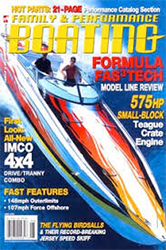Hot Stuff
With all things considered the greatest enemy of the modern stern drive is heat. Most stern drive manufacturers are well aware of this problem and have developed special lubricants to combat the effects of heat and the resulting thermal breakdown of the lubrication. Even so, drives still fail. The logical conclusion is that if we can control the heat, our drives should last much longer and our boating adventures should be trouble-free.
But the problem is twofold: (1) the heat produced by the drive, and (2) the sudden immersion of the drive into cold water as you come off plane. The cast aluminum alloy that is used in the modern stern drive does not respond favorably to the expansion and rapid contraction caused when a super-hot drive is plunged into cool water. This thermal shock condition is especial prevalent in high-performance applications where demands on the drive are pushed to the limit. A positive indicator that your drive is operating on the ragged edge is a white, chalky deposit on the top half of the upper gearcase or steam generated off the transom area each time the vessel comes off plane, And, of course, smelly, burned or black drive lubricant discovered at scheduled service intervals.
Solutions
There is a simple and afford able solution. It’s a drive shower. Drive showers have been around for decades and are utilized with great success on everything from houseboats to high—performance offshore boats. Their operation is simplicity at its best. The drive shower routes cool water from below the cavitation plate up to the upper bearing cap where the majority of the friction and heat is generated. Reducing the temperature of the drive further reduces the possibility of foaming and thermal breakdown of the oil, which will certainly lead to drive failure. Easy to install, a drive shower could add years the life of your stern drive.
Over the years, we have tested a variety of drive showers. Some worked well, while others were questionable. Traditional drive showers on the market today all use one in-take and delivery tube to deliver cool water to the top of the drive while the vessel is in motion. These showers are simple and effective. Our own tests have shown that they can reduce drive oil temperatures as much as 30 degrees under most conditions.
Recently, however, we discovered a new drive shower that takes this simple process and doubles its effectiveness, the Summit and the new Halo drive showers by Simrek Corp. expand on the theory that if one is good, two have to be twice as good. Their unique design utilizes two intake ports for more water volume and up to11 dump ports for uniform distribution of cooling water on the top and sides of the drive. By using even distribution of the cooling water and more water volume, in theory the drive should run cooler than a drive utilizing the traditional design. In theory, Simrek’s new design should be twice as effective, but being the skeptics that we are, we decided to put the Summit and the Halo to the test in three different, applications on three different styles of drives.
Putting It To The Test
To assure that all our testing was conducted in a fair and impartial manner and eliminating most variables, each drive was prepared for testing in the following manner: The drive was drained and refilled with MerCruiser High-Performance Gear Lube+ (PH 92-802854A 1} according to Mercury’s instructions. For all tests, the drive was brought to operating temperatures above 100 degrees F., and all trim settings were identical throughout the tests. All tests were conducted with two persons aboard and approximately three-quarters fuel load. On each test we first established and recorded baseline temperature. The tests consisted of a 3-mile run at 4100 rpm in both directions. On both test days the ambient temperature was 97 to 101 degrees and the water temperature was 85 to 87 degrees. All data were recorded using OPS, Stalker radar and a Consolidated Gear Smart analog drive temperature sensor.
First Off The Dock
Our first test was on a 28- foot Donzi sport boat equipped with twin 5.7-liter MerCruiser and Alpha I Gen II drives. The vessel was manifesting symptoms that would indicate the drives were overheating, including white deposits on the upper gearcase. We first brought the drives up to operating temperature and made the two runs according to our protocol to establish a baseline, recording peak drive temperatures of 218 to 241 degrees F. on both drives.
With our baseline established we installed the Summit drive showers. Even with the vessel in the water, we were able to install the showers in approximately 30 minutes. Installation was simple and straightforward and could be performed by any skipper with average mechanical ability. Be certain you use the template supplied by the manufacturer before drilling your cavitation pate and check it twice. One Important word of caution: Since our vessel was in the water during installation, we used a 9-volt cordless drill when drilling the required mounting holes. By all means, do not use a 110-volt drill near the water. Injury or death from electrical shock can occur.
After the installation, we duplicated the original test. To our amazement, the peak drive temperatures had now dropped to 187 to 190 degrees. This is a drop of approximately 50 degrees and well within the drive’s and our, comfort zone. We were so amazed that we performed the test again just to be sure. Again, the temperature had a significant drop. Although not as much of a drop as in the first test it was a considerable drop all the same. In speaking with a MerCruiser engineer, he said the reason we did not experience the same amount of drop was undoubtedly because of a common phenomenon called heat saturation.
Seeing is Believing
For our second test, we used a Formula 26-foot deep-V sport boat equipped with a single MerCruiser 7.4 LX MPF with a Bravo Ill drive with a 1.81 gear ratio. The vessel’s approximate weight was 4,700 lbs. On our baseline run, we recorded a high temperature of 273 degrees on the south run and 271 degrees on the north run. After installing the Halo Multiport drive shower and stabilizing the drive temperature, we conducted the same protocol used in the first test series. Test results were: On the north run, we recorded a peak temperature of 221 degrees and on the south run we recorded a peak temperature of 219 degrees.
On both test protocols, we experienced approximately a 47- to 52-degree reduction in drive temperature. To say the least we were pleased with the results.
Twin Bravo One Drives
Our third and final test vessel was a 32-foot Baja powered by stock MerCruiser 502s and twin Bravo One drives. Again, after establishing baseline temperatures, we installed the original Summit on the port drive and the Halo design on the starboard drive. (These drives were counter-rotating, and the starboard drive had a temperature reading of approximately 4 degrees higher than the port drive.) We then followed the same protocol used in the original test. To our astonishment, we found that we had recorded an 8- to 10-degree further drop in temperature in the drive equipped with the Halo drive shower over the drive equipped with the Summit shower, after taking into account the drive temperature differential. But what is noteworthy is that although the temperature in the Summit-equipped drive did record a slight temperature rise over time (2 to 4 degrees) due to what we again suspect was heat saturation, the drive equipped with the Halo unit did not experience the same phenomena. Needless to say, we were again impressed with the results.
We are not the only ones impressed by Simrek’s technology. The Multiport drive showers have been tested by and are now original equipment on many boats. They are also used by U.S. Customs on its high-performance drug interdiction vessels.
The Bottom Line
Both Simrek’s Summit and Halo drive showers work to control a stern drive’s worst enemy: heat. Simrek’s product is manufactured of polished stainless steel with high-quality hardware. We found Simrek’s customer service to be very responsive to our questions and inquiries, and its installation instructions were easily understood with excellent templates.
Multiport drive showers are available for all Alpha and Bravo stern drives, including those equipped with IMCO, Latham and other external steering systems. The new Halo design is for Bravo stern drives equipped with stabilizers or external steering systems that bolt to the top of the bearing cap. Simrek has also developed a new patented water pick-up that assures positive water flow and volume regard less of trim angle or bottom design, including cats and air— entrapment hulls.
Reprinted with permission from:
FAMILY & PERFORMANCE BOATING May 2003 issue, pages 67 to 69


